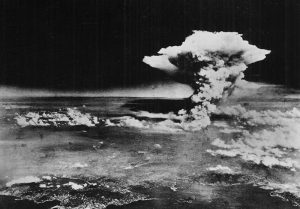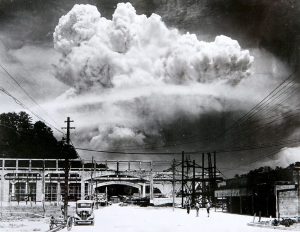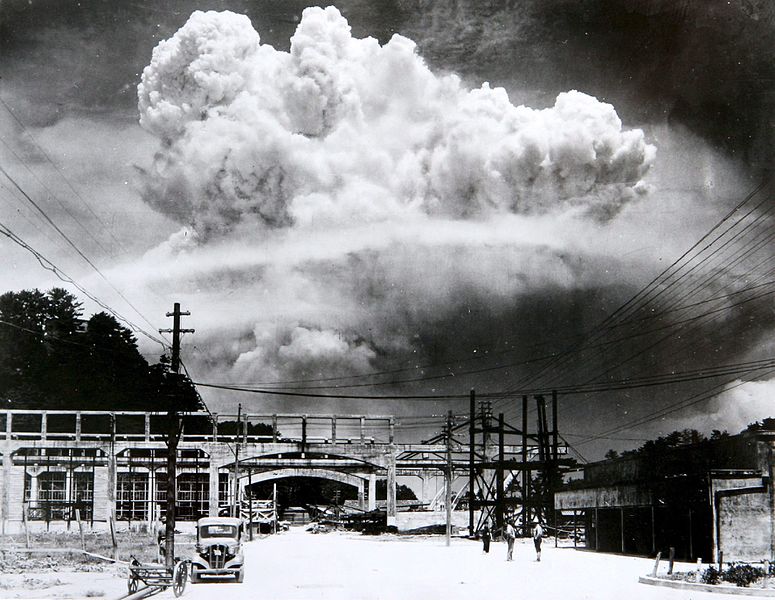“When the atomic bomb fell,
day turned to night and
people became ghosts.”
Hatsumi Sakamoto, Third Grader,
Hijiyama Elementary School, Hiroshima City, 1952
During the Cold War, people feared the devastating effects of nuclear war; many remembered the 1945 atomic attacks on the Japanese cities of Hiroshima and Nagasaki. This August marks 75 years since two American B-29 Superfortress bombers dropped the first nuclear weapons used in wartime.
The Manhattan Project – a joint nuclear science and research team composed of scientists from the United States, Great Britain and Canada – took three years to develop the atomic bomb. On 16 July 1945, they tested the first atomic weapon (a.k.a. “The Gadget”) in the New Mexico desert, better known as the Trinity test. The test bomb’s plutonium core was assembled by a Canadian, Winnipeg-born nuclear physicist Louis Slotin.
Hiroshima
 On 6 August 1945 at 8:15 a.m., the Enola Gay dropped the first atomic weapon to be used on a populated target. The bomb, nicknamed “Little Boy”, took 44 seconds to drop. Below, 14-year-old Vancouver-born Joe Ohari was buying a tram ticket to go to school. Like thousands of other Hiroshima residents, he was unaware of the sudden force that was about to devastate the city. “Little Boy” detonated 240 metres over the Shima Surgical Clinic; the destruction of Hiroshima was immediate and cataclysmic. “Being near the station, I thought the train exploded,” Ohari remembered. Within one billionth of a second the impact site reached temperatures 10,000 times hotter than the sun’s surface. “Suddenly,” he continued, “it felt as if you were trapped in a ball of fire.” The force and temperature of the bomb was enough to destroy an estimated 60,000 buildings within a 1.6 kilometre radius.
On 6 August 1945 at 8:15 a.m., the Enola Gay dropped the first atomic weapon to be used on a populated target. The bomb, nicknamed “Little Boy”, took 44 seconds to drop. Below, 14-year-old Vancouver-born Joe Ohari was buying a tram ticket to go to school. Like thousands of other Hiroshima residents, he was unaware of the sudden force that was about to devastate the city. “Little Boy” detonated 240 metres over the Shima Surgical Clinic; the destruction of Hiroshima was immediate and cataclysmic. “Being near the station, I thought the train exploded,” Ohari remembered. Within one billionth of a second the impact site reached temperatures 10,000 times hotter than the sun’s surface. “Suddenly,” he continued, “it felt as if you were trapped in a ball of fire.” The force and temperature of the bomb was enough to destroy an estimated 60,000 buildings within a 1.6 kilometre radius.
The human toll was shocking. Out of an estimated population of 255,260, the city of Hiroshima lost 140,000 people within the first few minutes of the bombing and during the resulting fallout. Thermal burns from the bomb flash were powerful enough to imprint clothing patterns onto skin. Victims developed radiation sickness and cancer from the high influx of gamma rays and neutrons released during the explosion. Joe Ohari survived with flash burns on his left hand and the side of his face. Despite a doctor telling him he would not survive, Ohari managed to find his family. When he returned to Hiroshima two months later, he recalled “as far as your eye could see, it was just an open field. Few out-buildings stood, but it was nothing to what I thought it was.”
American president Harry Truman, hoping to end the war, delivered news of the attack over a radio broadcast, informing the world and especially Japanese officials of the new atomic weapon. The world waited, but Japan did not surrender.
Nagasaki
 On August 9, three days after Hiroshima, the American bomber Bockscar took flight with a second atomic bomb, “Fat Man,” intending to attack the target city of Kokura. However, due to smoke and clouds from previous firebombings, the crew quickly changed coordinates to a secondary target: Nagasaki.
On August 9, three days after Hiroshima, the American bomber Bockscar took flight with a second atomic bomb, “Fat Man,” intending to attack the target city of Kokura. However, due to smoke and clouds from previous firebombings, the crew quickly changed coordinates to a secondary target: Nagasaki.
At 11:02 a.m., Bockscar released “Fat Man” over the city’s industrial district; it dropped for 43 seconds before detonating. Its intended targets were the Mitsubishi Steel and Arms Works and the Mitsubishi-Urakami Ordnance Works, which was constructing torpedoes. As “Fat Man” fell, Jack Ford, a 21-year-old prisoner of war from Port Aux Basques, Newfoundland, laboured in a nearby dockyard. Ford looked up to the sky and witnessed what he thought was “the end of the world.” Remembering the day, Ford said: “There wasn’t a cloud in the sky. And suddenly, as I was about to go for the bucket of green tea for the group, a blast struck us. When I looked towards Nagasaki, the sky had just blackened and the mushroom was just up on in the air.” Like Hiroshima, the decimation of Nagasaki was swift and disastrous.
The mushroom cloud reached over 40,000 feet in eight minutes. With a blast equivalent to the power of 21 tonnes of dynamite, “Fat Man” flattened half the city, including the intended targets. Like those of Hiroshima, the casualties were devastating. From an estimated population of 195,290, Nagasaki lost 80,000 people from the initial blast and resulting fallout. Jack Ford survived the attack, having only noted the heat flash of the explosion knocked him and his fellow prisoners of war to the ground.
Poor coordination had hampered American efforts to warn the residents of Nagasaki: a day after the attack, American planes dropped thousands of propaganda leaflets warning of an impending nuclear attack if Japan did not surrender. Japan surrendered August 14, leading to the end of the Second World War.
The bombings of Hiroshima and Nagasaki introduced the world to the terrifying power of nuclear energy. The devastating impact and loss of life served as a horrifying reminder to the world throughout the Cold War and into the present.
The Diefenbunker: Canada’s Cold War Museum remembers those who were lost.
Resources
For Joe Ohari’s testimony, listen here: https://www.cbc.ca/archives/entry/a-canadian-in-hiroshima
For resources on Jack Ford’s testimony, please watch here: https://www.cbc.ca/archives/entry/witness-at-nagasaki
https://www.cbc.ca/news/canada/newfoundland-labrador/sherren-remembering-john-ford-1.1868434
For the Pulitzer Prize-winning survivor testimonies, written by John Hershey in 1946, read here https://www.newyorker.com/magazine/1946/08/31/hiroshima
For more testimony and information, please visit the Hiroshima Peace Memorial Museum’s website and the the Nagasaki Peace and Atomic Bomb Museum’s website:
http://hpmmuseum.jp/modules/info/index.php?action=PageView&page_id=159&lang=eng
http://nagasakipeace.jp/english.html
For more artifacts from August 6th, please visit the Hiroshima Peace Memorial Museum’s website: http://a-bombdb.pcf.city.hiroshima.jp/pdbe/search/col_bombed
To view the surviving structures from August 9th, please visit the Nagasaki Peace and Atomic Bomb Museum: http://nagasakipeace.jp/english/survivors/1.html
